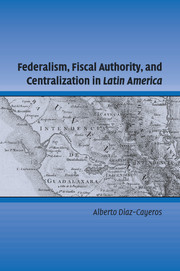Book contents
- Frontmatter
- Contents
- List of Figures
- List of Tables
- Preface
- Federalism, Fiscal Authority, and Centralization in Latin America
- 1 FEDERALISM, PARTY HEGEMONY, AND THE CENTRALIZATION OF FISCAL AUTHORITY
- Part I Fiscal Centralization in Mexico
- Part II Centralization and Revenue-Sharing in the Latin American Federations
- References
- Index
- Titles in the Series
Part I - Fiscal Centralization in Mexico
Published online by Cambridge University Press: 08 January 2010
- Frontmatter
- Contents
- List of Figures
- List of Tables
- Preface
- Federalism, Fiscal Authority, and Centralization in Latin America
- 1 FEDERALISM, PARTY HEGEMONY, AND THE CENTRALIZATION OF FISCAL AUTHORITY
- Part I Fiscal Centralization in Mexico
- Part II Centralization and Revenue-Sharing in the Latin American Federations
- References
- Index
- Titles in the Series
Summary
This book argues that the commitment problem in the dilemma of fiscal centralization was solved in the case of Mexico through a hegemonic party system. I show that the Partido Revolucionario Institucional (PRI), which ruled Mexico for seven decades, created a regional compromise: Local elites could maintain relative autonomy, being protected with the power and money of the federal government, while national elites could exercise discretion in the use of national financial resources in order to pursue a “developmentalist” strategy through import substituting industrialization (ISI). Moreover, local elites were willing to go along with this arrangement because the center ensured a flow of financial transfers and respected their local political careers as long as they did not run into conflict with the federal ambition ladder.
The consequences of this regional pact were perverse. On the one hand, Mexican federalism was diminished and political practices were far from any democratic ideal; on the other, regional development suffered because resources were concentrated in the regions that benefited from the centralized model of development. The arrangement was sustained for a long time because it was a strategic political equilibrium. Neither regional nor national elites would benefit from redrawing the federal pact. This arrangement was no longer feasible after the 1990s, once the center ceased to be able to provide resources for patronage and protection from local electoral threats.
The process of fiscal centralization is reflected in the national public finances throughout the century.
- Type
- Chapter
- Information
- Publisher: Cambridge University PressPrint publication year: 2006



